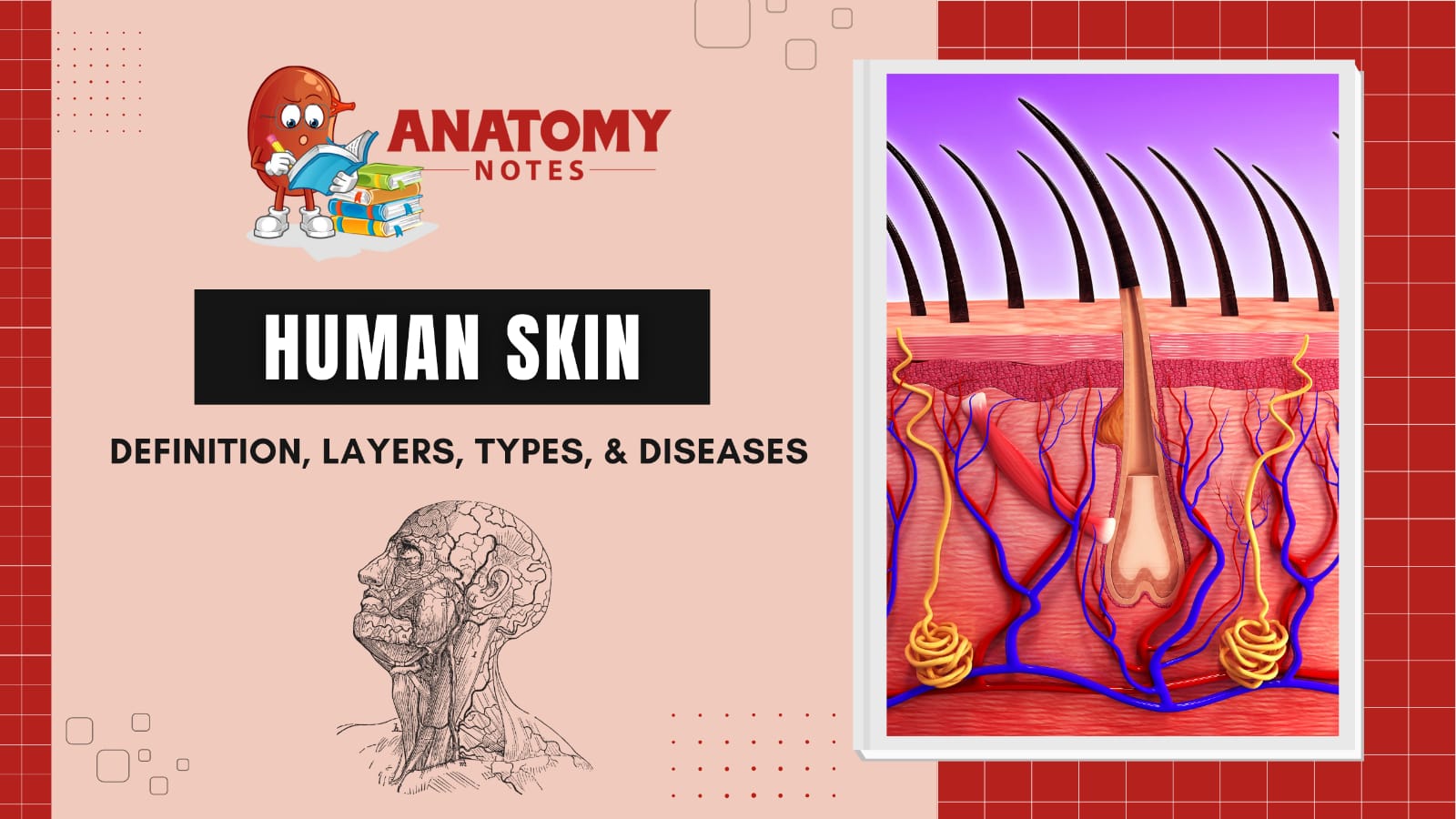Skin is the soft external surface covering of the human body. It is the largest organ of the body.
The skin is a connective tissue that consists of cells, fibers, and an extracellular matrix.
It is the foundation of the integumentary system which made up of different tissues that are joined to perform a specific function.
It is waterproof, stretchable, tough and washable. It covers the surface area of 1.5 – 2 square meters and it’s thickness varies from 3-3.5 mm.
The proportion of skin covering different parts of the human body can be explained in percentages as :
- Head and Neck = 9%
- Each upper limb = 9%
- Front of the trunk = 18%
- Back of the trunk (including buttocks) = 18%
- Each lower limb = 18%
- Perineum =1%
There are various accessory structures of the skin include hair, nails, sweat glands, and sebaceous glands.
These structures embryologically originate from the epidermis and can extend down through the dermis into the hypodermis.
The skin is continuous with the mucous membrane at the orifices of the body.
The skin and its accessory structures perform a variety of important functions, such as protecting the body from surrounding microorganisms, chemicals, and other environmental factors; preventing dehydration; acting as a sensory organ; modulating body temperature and electrolyte balance, and synthesizing vitamin D.
The underlying hypodermis has important roles in storing fats, forming a “cushion” over underlying structures, and providing insulation from cold temperatures.
The skin has mesodermal cells, pigmentation, such as melanin provided by melanocytes, which absorb some of the potentially dangerous ultraviolet radiation (UV) in sunlight.
It also contains DNA repair enzymes that help reverse UV damage, such that people lacking the genes for these enzymes suffer high rates of skin cancer.
One form predominantly produced by UV light, malignant melanoma, is particularly invasive, causing it to spread quickly, and can often be deadly.
Human skin pigmentation varies among populations in a striking manner due to which we can classify the person on the basis of skin color.
This assessment is very important in cases involving burns, where the patient requires treatment according to the magnitude of the damaged area of skin.
Functions of skin
Protection
- The skin protects the rest of the body from the basic elements of nature such as wind, water, and UV sunlight.
- It acts as a protective barrier against water loss, due to the presence of layers of keratin and glycolipids in the stratum carenum.
- It also is the first line of defense against abrasive activity due to contact with grit, microbes, or harmful chemicals.
- Sweat excreted from sweat glands deters microbes from over-colonizing the skin surface by generating dermcidin, which has antibiotic properties.
Sensation
- The skin contains a variety of nerve endings that react to heat and cold, touch, pressure, vibration, and tissue injury.
Heat regulation
- The skin contains a blood supply far greater than its requirements which allows precise control of energy loss by radiation, convection, and conduction.
- Dilated blood vessels increase perfusion and heat loss, while constricted vessels greatly reduce cutaneous blood flow and conserve heat.
Water resistance
- The skin acts as a water-resistant barrier so essential nutrients are not washed out of the body.
Excretion
- Sweat contains urea, however, its concentration is 1/130th that of urine, hence excretion by sweating is at most a secondary function to temperature regulation.
Prevent dehydration
- The skin forms a waterproof layer all around the body thus preventing excessive loss of water, which is vital for people living in deserts and dry.
Vitamin D synthesis
- The epidermal layer of human skin synthesizes vitamin D when exposed to UV radiation.
Frequently Asked Questions (FAQs)
What is skin made of ?
Skin is composed of three main layers: the epidermis, dermis, and hypodermis (subcutaneous tissue). The epidermis is the outermost layer and contains the protective barrier that shields the body from environmental factors. The dermis is the middle layer and contains connective tissue, sweat glands, and hair follicles. The hypodermis is the innermost layer and is made up of adipose tissue and connective tissue.
What is human skin size?
The size of human skin varies depending on the individual’s body size, age, and gender. On average, adult human skin covers an area of approximately 1.5 to 2 square meters (16 to 22 square feet). However, the actual size can vary depending on factors such as body weight, height, and muscle mass. Additionally, the thickness of the skin varies in different areas of the body, with the thickest skin being found on the soles of the feet and the thinnest on the eyelids.
What is skin called?
The outermost layer of the body that covers and protects it is called the skin. The skin is the largest organ of the body and it serves many important functions such as protecting the body from external factors like harmful UV rays, regulating body temperature, and helping to maintain the body’s hydration levels. The skin is also responsible for the sense of touch and plays an important role in the immune system by providing a barrier against infections.
What gives skin its color?
The color of human skin is primarily determined by the amount and type of a pigment called melanin, which is produced by specialized cells called melanocytes located in the epidermis (outer layer of the skin). The more melanin produced by these cells, the darker the skin will appear. Other factors that can influence skin color include genetics, sun exposure, and certain medical conditions.
How thick is skin?
The thickness of the skin varies in different areas of the body. On average, the skin is approximately 0.5 millimeters thick, but it can range from as thin as 0.05 millimeters on the eyelids to as thick as 4 millimeters on the soles of the feet. The skin is thickest on areas of the body that are subject to the most wear and tear, such as the palms of the hands and the soles of the feet, and thinnest on areas of the body that are more delicate and sensitive, such as the eyelids and the genital area. The thickness of the skin also varies depending on factors such as age, gender, and overall health.
Why is skin an organ?
Skin is considered an organ because it is a complex structure that performs multiple functions in the body. As the largest organ in the body, the skin acts as a barrier that protects the body from external factors such as microbes, UV radiation, and environmental toxins. It also plays an important role in regulating body temperature, maintaining proper hydration levels, and providing the sense of touch.




